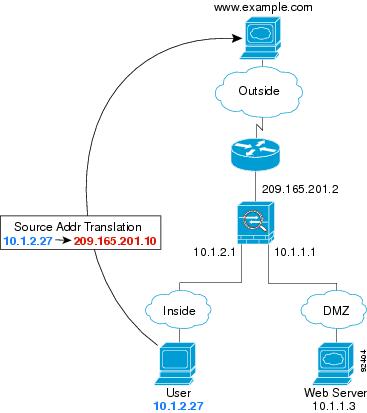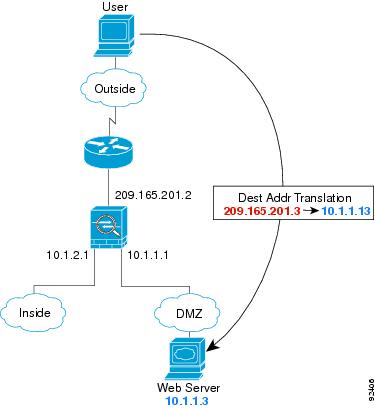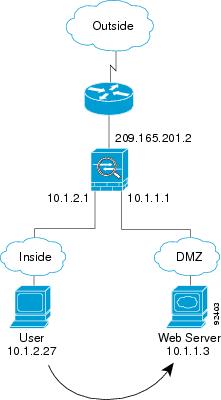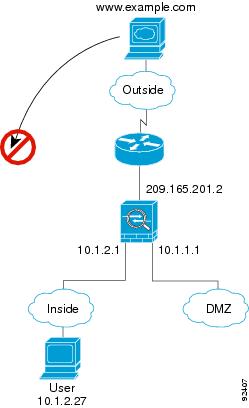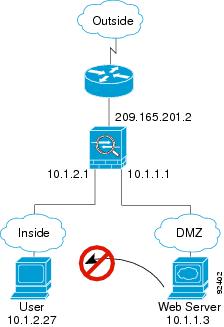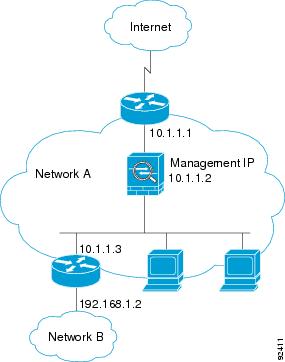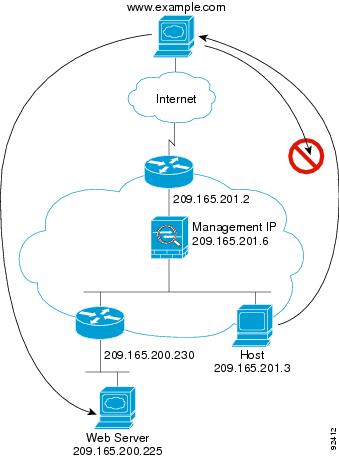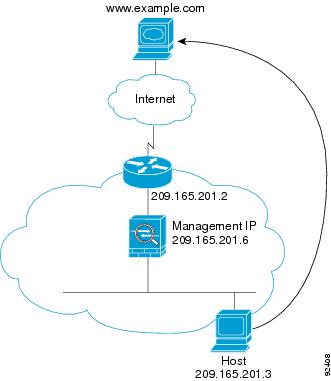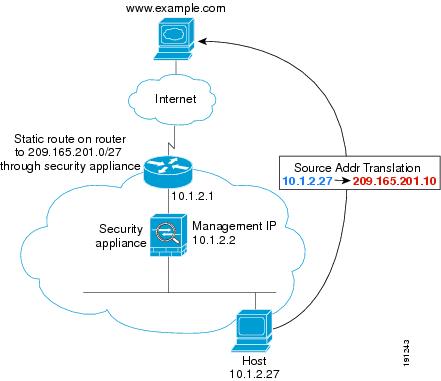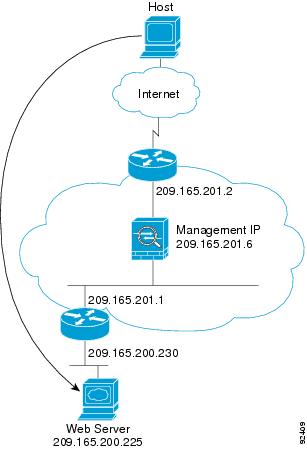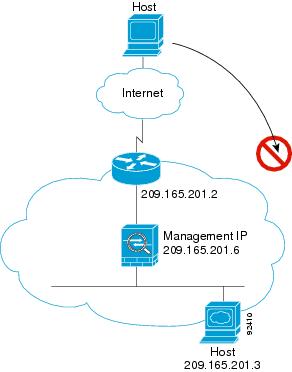

-
Cisco Security Appliance Command Line Configuration Guide, Version 8.0
-
About This Guide
-
Getting Started and General Information
-
Introduction to the Security Appliance
-
Getting Started
-
Managing Feature Licenses
-
Enabling Multiple Context Mode
-
Configuring Interfaces for the Cisco ASA 5505 Adaptive Security Appliance
-
Configuring Ethernet Settings and Subinterfaces
-
Adding and Managing Security Contexts
-
Configuring Interface Parameters
-
Configuring Basic Settings
-
Configuring IP Routing
-
Configuring Multicast Routing
-
Configuring DHCP, DDNS, and WCCP Services
-
Configuring IPv6
-
Configuring AAA Servers and the Local Database
-
Configuring Failover
-
Using Modular Policy Framework
-
-
Configuring the Firewall
-
Firewall Mode Overview
-
Identifying Traffic With Access Lists
-
Configuring NAT
-
Permitting or Denying Network Access
-
Applying AAA for Network Access
-
Applying Filtering Services
-
Managing AIP SSM and CSC SSM
-
Preventing Network Attacks
-
Applying QoS Policies
-
Applying Application Layer Protocol Inspection
-
Configuring Cisco Unified Communications Support
-
Configuring ARP Inspection and Bridging Parameters in Transparent Mode
-
-
Configuring VPN
-
Configuring IPSec and ISAKMP
-
Configuring L2TP over IPSec
-
Setting General VPN Parameters
-
Configuring Tunnel Groups, Group Policies, and Users
-
Configuring IP Addresses for VPN
-
Configuring Remote Access VPNs
-
Configuring Network Admission Control
-
Configuring Easy VPN on the ASA 5505
-
Configuring the PPPoE Client
-
Configuring LAN-to-LAN VPNs
-
Configuring Clientless SSL VPN
-
Configuring AnyConnect VPN Client Connections
-
Configuring Certificates
-
- System Administration
- Reference
-
Glossary
-
Table Of Contents
How Data Moves Through the Security Appliance in Routed Firewall Mode
An Inside User Visits a Web Server
An Outside User Visits a Web Server on the DMZ
An Inside User Visits a Web Server on the DMZ
An Outside User Attempts to Access an Inside Host
A DMZ User Attempts to Access an Inside Host
Passing Traffic Not Allowed in Routed Mode
Using the Transparent Firewall in Your Network
Transparent Firewall Guidelines
Unsupported Features in Transparent Mode
How Data Moves Through the Transparent Firewall
An Inside User Visits a Web Server
An Inside User Visits a Web Server Using NAT
An Outside User Visits a Web Server on the Inside Network
An Outside User Attempts to Access an Inside Host
Firewall Mode Overview
This chapter describes how the firewall works in each firewall mode. To set the firewall mode, see the "Setting Transparent or Routed Firewall Mode" section.
Note
In multiple context mode, you cannot set the firewall mode separately for each context; you can only set the firewall mode for the entire security appliance.
This chapter includes the following sections:
Routed Mode Overview
In routed mode, the security appliance is considered to be a router hop in the network. It can use OSPF or RIP (in single context mode). Routed mode supports many interfaces. Each interface is on a different subnet. You can share interfaces between contexts.
This section includes the following topics:
•
How Data Moves Through the Security Appliance in Routed Firewall Mode
IP Routing Support
The security appliance acts as a router between connected networks, and each interface requires an IP address on a different subnet. In single context mode, the routed firewall supports OSPF, EIGRP, and RIP. Multiple context mode supports static routes only. We recommend using the advanced routing capabilities of the upstream and downstream routers instead of relying on the security appliance for extensive routing needs.
How Data Moves Through the Security Appliance in Routed Firewall Mode
This section describes how data moves through the security appliance in routed firewall mode, and includes the following topics:
•
An Inside User Visits a Web Server
•
An Outside User Visits a Web Server on the DMZ
•
An Inside User Visits a Web Server on the DMZ
•
An Outside User Attempts to Access an Inside Host
•
A DMZ User Attempts to Access an Inside Host
An Inside User Visits a Web Server
Figure 17-1 shows an inside user accessing an outside web server.
Figure 17-1 Inside to Outside
The following steps describe how data moves through the security appliance (see Figure 17-1):
1.
The user on the inside network requests a web page from www.example.com.
2.
The security appliance receives the packet and because it is a new session, the security appliance verifies that the packet is allowed according to the terms of the security policy (access lists, filters, AAA).
For multiple context mode, the security appliance first classifies the packet according to either a unique interface or a unique destination address associated with a context; the destination address is associated by matching an address translation in a context. In this case, the interface would be unique; the www.example.com IP address does not have a current address translation in a context.
3.
The security appliance translates the local source address (10.1.2.27) to the global address 209.165.201.10, which is on the outside interface subnet.
The global address could be on any subnet, but routing is simplified when it is on the outside interface subnet.
4.
The security appliance then records that a session is established and forwards the packet from the outside interface.
5.
When www.example.com responds to the request, the packet goes through the security appliance, and because the session is already established, the packet bypasses the many lookups associated with a new connection. The security appliance performs NAT by translating the global destination address to the local user address, 10.1.2.27.
6.
The security appliance forwards the packet to the inside user.
An Outside User Visits a Web Server on the DMZ
Figure 17-2 shows an outside user accessing the DMZ web server.
Figure 17-2 Outside to DMZ
The following steps describe how data moves through the security appliance (see Figure 17-2):
1.
A user on the outside network requests a web page from the DMZ web server using the global destination address of 209.165.201.3, which is on the outside interface subnet.
2.
The security appliance receives the packet and because it is a new session, the security appliance verifies that the packet is allowed according to the terms of the security policy (access lists, filters, AAA).
For multiple context mode, the security appliance first classifies the packet according to either a unique interface or a unique destination address associated with a context; the destination address is associated by matching an address translation in a context. In this case, the classifier "knows" that the DMZ web server address belongs to a certain context because of the server address translation.
3.
The security appliance translates the destination address to the local address 10.1.1.3.
4.
The security appliance then adds a session entry to the fast path and forwards the packet from the DMZ interface.
5.
When the DMZ web server responds to the request, the packet goes through the security appliance and because the session is already established, the packet bypasses the many lookups associated with a new connection. The security appliance performs NAT by translating the local source address to 209.165.201.3.
6.
The security appliance forwards the packet to the outside user.
An Inside User Visits a Web Server on the DMZ
Figure 17-3 shows an inside user accessing the DMZ web server.
Figure 17-3 Inside to DMZ
The following steps describe how data moves through the security appliance (see Figure 17-3):
1.
A user on the inside network requests a web page from the DMZ web server using the destination address of 10.1.1.3.
2.
The security appliance receives the packet and because it is a new session, the security appliance verifies that the packet is allowed according to the terms of the security policy (access lists, filters, AAA).
For multiple context mode, the security appliance first classifies the packet according to either a unique interface or a unique destination address associated with a context; the destination address is associated by matching an address translation in a context. In this case, the interface is unique; the web server IP address does not have a current address translation.
3.
The security appliance then records that a session is established and forwards the packet out of the DMZ interface.
4.
When the DMZ web server responds to the request, the packet goes through the fast path, which lets the packet bypass the many lookups associated with a new connection.
5.
The security appliance forwards the packet to the inside user.
An Outside User Attempts to Access an Inside Host
Figure 17-4 shows an outside user attempting to access the inside network.
Figure 17-4 Outside to Inside
The following steps describe how data moves through the security appliance (see Figure 17-4):
1.
A user on the outside network attempts to reach an inside host (assuming the host has a routable IP address).
If the inside network uses private addresses, no outside user can reach the inside network without NAT. The outside user might attempt to reach an inside user by using an existing NAT session.
2.
The security appliance receives the packet and because it is a new session, the security appliance verifies if the packet is allowed according to the security policy (access lists, filters, AAA).
3.
The packet is denied, and the security appliance drops the packet and logs the connection attempt.
If the outside user is attempting to attack the inside network, the security appliance employs many technologies to determine if a packet is valid for an already established session.
A DMZ User Attempts to Access an Inside Host
Figure 17-5 shows a user in the DMZ attempting to access the inside network.
Figure 17-5 DMZ to Inside
The following steps describe how data moves through the security appliance (see Figure 17-5):
1.
A user on the DMZ network attempts to reach an inside host. Because the DMZ does not have to route the traffic on the Internet, the private addressing scheme does not prevent routing.
2.
The security appliance receives the packet and because it is a new session, the security appliance verifies if the packet is allowed according to the security policy (access lists, filters, AAA).
3.
The packet is denied, and the security appliance drops the packet and logs the connection attempt.
Transparent Mode Overview
Traditionally, a firewall is a routed hop and acts as a default gateway for hosts that connect to one of its screened subnets. A transparent firewall, on the other hand, is a Layer 2 firewall that acts like a "bump in the wire," or a "stealth firewall," and is not seen as a router hop to connected devices.
This section describes transparent firewall mode, and includes the following topics:
•
Passing Traffic Not Allowed in Routed Mode
•
MAC Address vs. Route Lookups
•
Using the Transparent Firewall in Your Network
•
Transparent Firewall Guidelines
•
Unsupported Features in Transparent Mode
•
How Data Moves Through the Transparent Firewall
Transparent Firewall Network
The security appliance connects the same network on its inside and outside interfaces. Because the firewall is not a routed hop, you can easily introduce a transparent firewall into an existing network.
Allowing Layer 3 Traffic
IPv4 traffic is allowed through the transparent firewall automatically from a higher security interface to a lower security interface, without an access list. ARPs are allowed through the transparent firewall in both directions without an access list. ARP traffic can be controlled by ARP inspection. For Layer 3 traffic travelling from a low to a high security interface, an extended access list is required on the low security interface. See the "Adding an Extended Access List" section for more information.
Allowed MAC Addresses
The following destination MAC addresses are allowed through the transparent firewall. Any MAC address not on this list is dropped.
•
TRUE broadcast destination MAC address equal to FFFF.FFFF.FFFF
•
IPv4 multicast MAC addresses from 0100.5E00.0000 to 0100.5EFE.FFFF
•
IPv6 multicast MAC addresses from 3333.0000.0000 to 3333.FFFF.FFFF
•
BPDU multicast address equal to 0100.0CCC.CCCD
•
Appletalk multicast MAC addresses from 0900.0700.0000 to 0900.07FF.FFFF
Passing Traffic Not Allowed in Routed Mode
In routed mode, some types of traffic cannot pass through the security appliance even if you allow it in an access list. The transparent firewall, however, can allow almost any traffic through using either an extended access list (for IP traffic) or an EtherType access list (for non-IP traffic).
Note
The transparent mode security appliance does not pass CDP packets or IPv6 packets, or any packets that do not have a valid EtherType greater than or equal to 0x600. For example, you cannot pass IS-IS packets. An exception is made for BPDUs, which are supported.
For example, you can establish routing protocol adjacencies through a transparent firewall; you can allow OSPF, RIP, EIGRP, or BGP traffic through based on an extended access list. Likewise, protocols like HSRP or VRRP can pass through the security appliance.
Non-IP traffic (for example AppleTalk, IPX, BPDUs, and MPLS) can be configured to go through using an EtherType access list.
For features that are not directly supported on the transparent firewall, you can allow traffic to pass through so that upstream and downstream routers can support the functionality. For example, by using an extended access list, you can allow DHCP traffic (instead of the unsupported DHCP relay feature) or multicast traffic such as that created by IP/TV.
BPDU Handling
To prevent loops using the spanning tree protocol, BPDUs are passed by default. To block BPDUs, you need to configure an EtherType access list to deny them. If you are using failover, you might want to block BPDUs to prevent the switch port from going into a blocking state when the topology changes. See the "Transparent Firewall Mode Requirements" section for more information.
MAC Address vs. Route Lookups
When the security appliance runs in transparent mode, the outgoing interface of a packet is determined by performing a MAC address lookup instead of a route lookup.
Route lookups, however, are necessary for the following traffic types:
•
Traffic originating on the security appliance—For example, if your syslog server is located on a remote network, you must use a static route so the security appliance can reach that subnet.
•
Voice over IP (VoIP) traffic with inspection enabled, and the endpoint is at least one hop away from the security appliance—For example, if you use the transparent firewall between a CCM and an H.323 gateway, and there is a router between the transparent firewall and the H.323 gateway, then you need to add a static route on the security appliance for the H.323 gateway for successful call completion.
•
VoIP or DNS traffic with NAT and inspection enabled—To successfully translate the IP address inside VoIP and DNS packets, the security appliance needs to perform a route lookup. Unless the host is on a directly-connected network, then you need to add a static route on the security appliance for the real host address that is embedded in the packet.
Using the Transparent Firewall in Your Network
Figure 17-6 shows a typical transparent firewall network where the outside devices are on the same subnet as the inside devices. The inside router and hosts appear to be directly connected to the outside router.
Figure 17-6 Transparent Firewall Network
Transparent Firewall Guidelines
Follow these guidelines when planning your transparent firewall network:
•
A management IP address is required; for multiple context mode, an IP address is required for each context.
Unlike routed mode, which requires an IP address for each interface, a transparent firewall has an IP address assigned to the entire device. The security appliance uses this IP address as the source address for packets originating on the security appliance, such as system messages or AAA communications.
The management IP address must be on the same subnet as the connected network. You cannot set the subnet to a host subnet (255.255.255.255).
You can configure an IP address for the Management 0/0 management-only interface. This IP address can be on a separate subnet from the main management IP address.
Note
If the management IP address is not configured, transient traffic does not pass through the transparent firewall. For multiple context mode, transient traffic does not pass through virtual contexts.
•
The transparent security appliance uses an inside interface and an outside interface only. If your platform includes a dedicated management interface, you can also configure the management interface or subinterface for management traffic only.
In single mode, you can only use two data interfaces (and the dedicated management interface, if available) even if your security appliance includes more than two interfaces.
Note
In transparent firewall mode, the management interface updates the MAC address table in the same manner as a data interface; therefore you should not connect both a management and a data interface to the same switch unless you configure one of the switch ports as a routed port (by default Cisco Catalyst switches share a MAC address for all VLAN switch ports). Otherwise, if traffic arrives on the management interface from the physically-connected switch, then the security appliance updates the MAC address table to use the management interface to access the switch, instead of the data interface. This action causes a temporary traffic interruption; the security appliance will not re-update the MAC address table for packets from the switch to the data interface for at least 30 seconds for security reasons.
•
Each directly connected network must be on the same subnet.
•
Do not specify the security appliance management IP address as the default gateway for connected devices; devices need to specify the router on the other side of the security appliance as the default gateway.
•
For multiple context mode, each context must use different interfaces; you cannot share an interface across contexts.
•
For multiple context mode, each context typically uses a different subnet. You can use overlapping subnets, but your network topology requires router and NAT configuration to make it possible from a routing standpoint.
Unsupported Features in Transparent Mode
Table 17-1 lists the features are not supported in transparent mode.
How Data Moves Through the Transparent Firewall
Figure 17-7 shows a typical transparent firewall implementation with an inside network that contains a public web server. The security appliance has an access list so that the inside users can access Internet resources. Another access list lets the outside users access only the web server on the inside network.
Figure 17-7 Typical Transparent Firewall Data Path
This section describes how data moves through the security appliance, and includes the following topics:
•
An Inside User Visits a Web Server
•
An Inside User Visits a Web Server Using NAT
•
An Outside User Visits a Web Server on the Inside Network
•
An Outside User Attempts to Access an Inside Host
An Inside User Visits a Web Server
Figure 17-8 shows an inside user accessing an outside web server.
Figure 17-8 Inside to Outside
The following steps describe how data moves through the security appliance (see Figure 17-8):
1.
The user on the inside network requests a web page from www.example.com.
2.
The security appliance receives the packet and adds the source MAC address to the MAC address table, if required. Because it is a new session, it verifies that the packet is allowed according to the terms of the security policy (access lists, filters, AAA).
For multiple context mode, the security appliance first classifies the packet according to a unique interface.
3.
The security appliance records that a session is established.
4.
If the destination MAC address is in its table, the security appliance forwards the packet out of the outside interface. The destination MAC address is that of the upstream router, 209.165.201.2.
If the destination MAC address is not in the security appliance table, the security appliance attempts to discover the MAC address by sending an ARP request or a ping. The first packet is dropped.
5.
The web server responds to the request; because the session is already established, the packet bypasses the many lookups associated with a new connection.
6.
The security appliance forwards the packet to the inside user.
An Inside User Visits a Web Server Using NAT
Figure 17-8 shows an inside user accessing an outside web server.
Figure 17-9 Inside to Outside with NAT
The following steps describe how data moves through the security appliance (see Figure 17-8):
1.
The user on the inside network requests a web page from www.example.com.
2.
The security appliance receives the packet and adds the source MAC address to the MAC address table, if required. Because it is a new session, it verifies that the packet is allowed according to the terms of the security policy (access lists, filters, AAA).
For multiple context mode, the security appliance first classifies the packet according to a unique interface.
3.
The security appliance translates the real address (10.1.2.27) to the mapped address 209.165.201.10.
Because the mapped address is not on the same network as the outside interface, then be sure the upstream router has a static route to the mapped network that points to the security appliance.
4.
The security appliance then records that a session is established and forwards the packet from the outside interface.
5.
If the destination MAC address is in its table, the security appliance forwards the packet out of the outside interface. The destination MAC address is that of the upstream router, 10.1.2.1.
If the destination MAC address is not in the security appliance table, the security appliance attempts to discover the MAC address by sending an ARP request and a ping. The first packet is dropped.
6.
The web server responds to the request; because the session is already established, the packet bypasses the many lookups associated with a new connection.
7.
The security appliance performs NAT by translating the mapped address to the real address, 10.1.2.27.
An Outside User Visits a Web Server on the Inside Network
Figure 17-10 shows an outside user accessing the inside web server.
Figure 17-10 Outside to Inside
The following steps describe how data moves through the security appliance (see Figure 17-10):
1.
A user on the outside network requests a web page from the inside web server.
2.
The security appliance receives the packet and adds the source MAC address to the MAC address table, if required. Because it is a new session, it verifies that the packet is allowed according to the terms of the security policy (access lists, filters, AAA).
For multiple context mode, the security appliance first classifies the packet according to a unique interface.
3.
The security appliance records that a session is established.
4.
If the destination MAC address is in its table, the security appliance forwards the packet out of the inside interface. The destination MAC address is that of the downstream router, 209.165.201.1.
If the destination MAC address is not in the security appliance table, the security appliance attempts to discover the MAC address by sending an ARP request and a ping. The first packet is dropped.
5.
The web server responds to the request; because the session is already established, the packet bypasses the many lookups associated with a new connection.
6.
The security appliance forwards the packet to the outside user.
An Outside User Attempts to Access an Inside Host
Figure 17-11 shows an outside user attempting to access a host on the inside network.
Figure 17-11 Outside to Inside
The following steps describe how data moves through the security appliance (see Figure 17-11):
1.
A user on the outside network attempts to reach an inside host.
2.
The security appliance receives the packet and adds the source MAC address to the MAC address table, if required. Because it is a new session, it verifies if the packet is allowed according to the terms of the security policy (access lists, filters, AAA).
For multiple context mode, the security appliance first classifies the packet according to a unique interface.
3.
The packet is denied because there is no access list permitting the outside host, and the security appliance drops the packet.
4.
If the outside user is attempting to attack the inside network, the security appliance employs many technologies to determine if a packet is valid for an already established session.

 Feedback
Feedback
